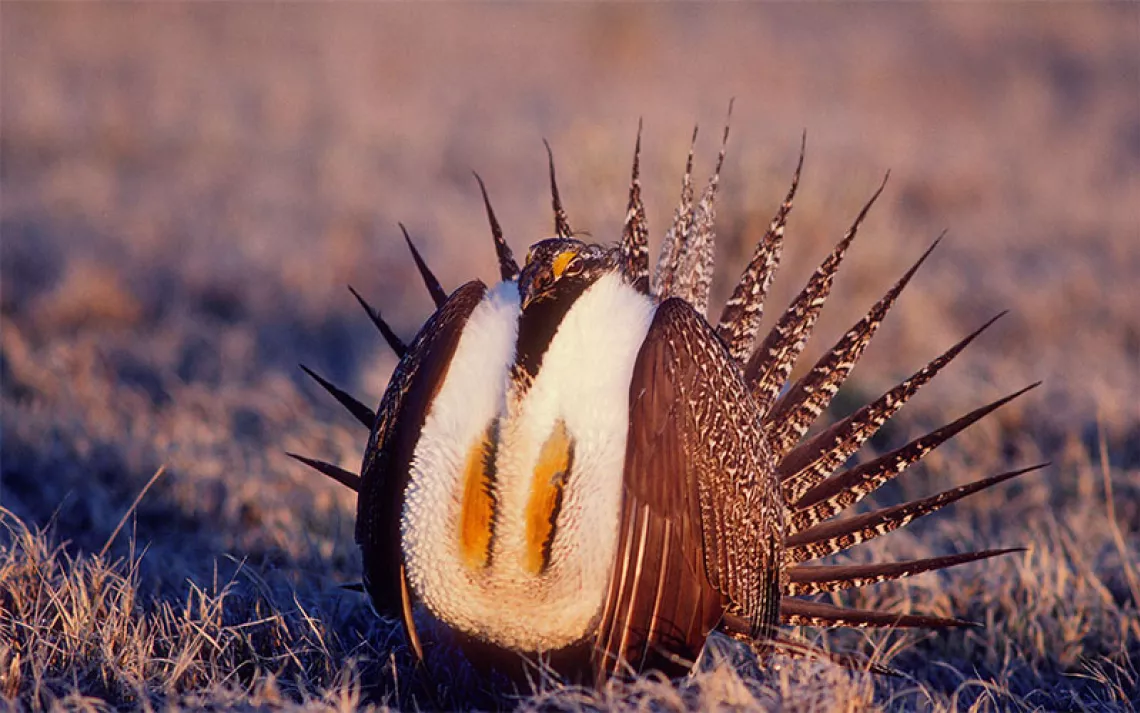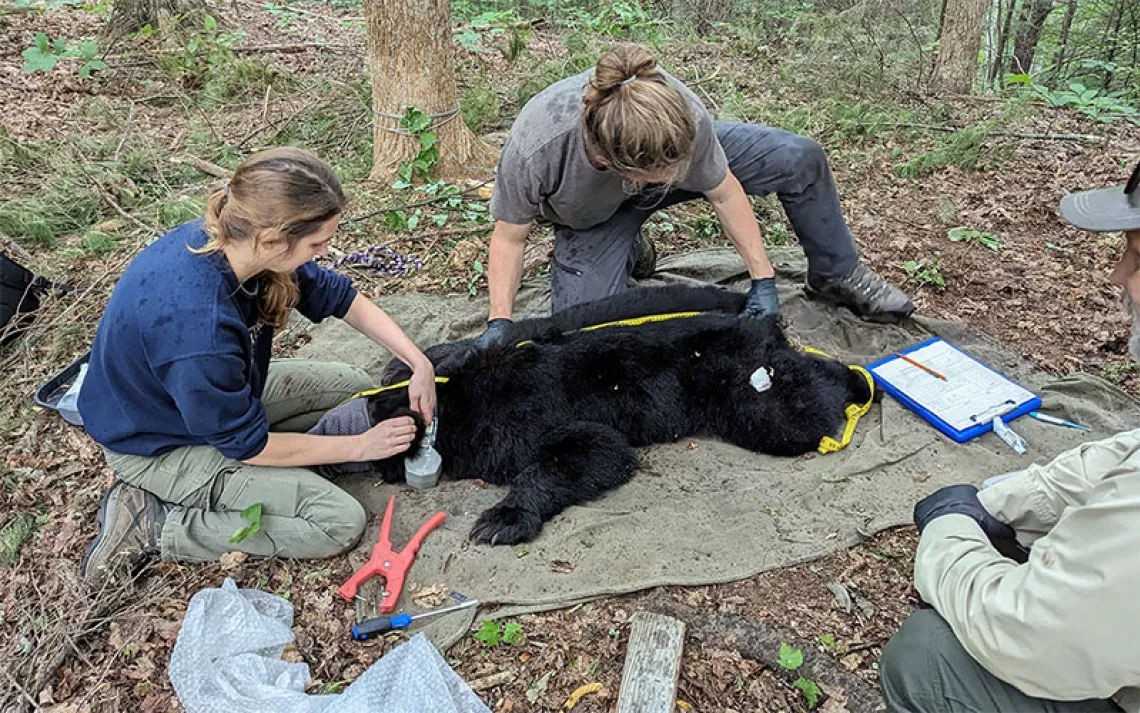New Maryland Law Is a Boon for Wildlife
How the acres below power lines could be a lifeline to animals on the move

Photo byrzelich/iStock
When Michael Wilpers took a course on winter plant identification hosted by a local naturalist society, the instructor pointed to a recently shorn transmission line corridor and lamented, “If the power company stopped mowing, this could be an excellent meadow.” Wilpers, an active member of the Maryland-based nonprofit Friends of Sligo Creek, decided it couldn’t hurt to ask Pepco, the power company that owned the transmission line.
At first, the answer was a definitive no. Its forester told Wilpers that not mowing the grass beneath the power line would violate local weed ordinances and draw the ire of nearby homeowners. But a few years later, when Wilpers learned a new forester had taken the helm, he tried again. Surprisingly, the new guy said yes.
Today, the quarter-mile strip of land that once resembled a front lawn has returned to its wild roots, quite literally. After mowing was reduced from six times to once a year, 125 native plants sprang up from the soil. It didn’t take long for the bees to arrive—97 species all told—along with 21 different kinds of butterflies and six kinds of grasshoppers. The grassland birds were next: blue grosbeaks, indigo buntings, American kestrels. Even a lone ruffed grouse made an appearance.
Homeowners who live adjacent to the new meadow have largely reacted not with ire but with wonder. Now they can look out their window to see foraging turkeys, circling hawks, or wrestling fox kits.
Jason Clayton, president of the Carole Highlands Neighborhood Association, says the restored meadow quickly became an asset in a community that had once lacked green space. Residents flock to the power line to enjoy a dose of nature, including his eight-year-old daughter. “She loves it there, loves all the critters,” Clayton says.
“For me, it’s the variety of butterflies," says Carole Highlands resident Kristin Zimmer, “the tiny ones, the ones I didn’t even know existed.”
In 2020, Zimmer, Clayton, and Wilpers asked Pepco to extend the meadow by another few acres. This time, however, their campaign was met with pushback from the county.
Almost all of Maryland’s 23 counties have a weed ordinance, which requires homeowners to keep vegetation shorter than 12 inches. In 2021, the legislature passed a law preventing HOAs from enforcing the ordinance on homeowners growing native plants or pollinator gardens. Could the law apply to power companies as well, Wilpers wondered? Once again, he decided to ask.
“I thought ‘what the heck’ and emailed my representative.”
As it turns out, the law didn’t apply to utilities, but Wilpers’ representative, Delegate Lorig Charkoudian, was willing to try to pass one that did.
This past May, Governor Wes Moore signed HB 62 into law after it flew through both chambers of the Maryland General Assembly. It exempts power companies from land-use restrictions like weed ordinances on property being managed as pollinator habitat. “Pollinator-friendly vegetation management,” as the law defines it, means mowing only half of the property once two years between November and March.
Importantly, the law doesn’t require the power company to turn all of its transmission line corridors (sometimes referred to as easements or rights-of-way) into fields of wildflowers. It just removes a major barrier for them to do so.
That’s a big deal in a region that has lost 90 percent of its grasslands and in a state where 70 percent of rare, threatened, and endangered plant species grow in grassland habitats. But Maryland is hardly unique. According to the National Wildlife Foundation, more than 70 percent of America’s prairies have been lost, while grassland birds are in steep decline.
What the nation has in spades, as anyone who’s taken a drive through suburbia lately knows, is power lines—and below them, land. An estimated 9 million acres that, if managed correctly, could help stem the tide for grassland-loving species like box turtles, bobwhite quail, and eastern monarchs.
Biologists and environmentalists have long recognized the value of transmission line corridors as grassy, scrubby places that could still thrive. A 2008 Audubon field guide to New England called them “one of the region’s most important open spaces.”
Before he started studying the biodiversity potential of utility rights-of-way, David Wagner, an ecologist at the University of Connecticut, used to take his kids to hang out in them.
“You could actually see the wildlife,” he says. “It was a great place to go frogging and catch snakes.”
Open spaces are a rare commodity in the Northeast, where in recent decades yawning agricultural landscapes have given way to reforesting and aggressive development. “Grasslands make great cemeteries, golf courses, and housing developments,” the ecologist says. Today, as much as 50 percent of the region’s remaining grassland is found beneath its power lines.
To quantify just how many living things make their homes in these corridors, Wagner and his colleagues spent years studying an 85-mile transmission line corridor that stretched from Connecticut to New Hampshire. In it they found a staggering 326 plant species (more than double the amount that grew in the adjacent forest) as well as 205 types of bees, nearly half of the known species in New England. Among them was the silver-and-black haired bee, a species that was once thought to be extirpated from the US.
Back in Maryland, power companies Pepco and Baltimore Gas & Electric already manage about 30 miles of their lines with biodiversity in mind, but the vast majority—until now—have been located on state or federal park land.
“The new law codifies the work we’ve been doing,” says Will Ellis, director of governmental and external affairs for Pepco, while giving neighborhoods adjacent to transmission line corridors ultimate say over what happens in them. According to Ellis, who’s received calls from customers interested in pollinator habitat since the law was passed, the number of communities who’d like to turn their power line into a meadow is on the rise.
Carole Highlands residents continue to find ways to improve their meadow. Zimmer recently convinced the county to revamp a stormwater culvert, and Clayton reports that guided hikes and bird walks are “picking up steam.”
Wilpers, meanwhile, is kicking around ideas to make sure the new law has a wide reach. He’d like to see a simple application process set up for neighborhoods to request pollinator habitat, or perhaps a commitment from utility companies to set aside a certain percentage of their acres for pollinators. He doesn’t know if it’s possible, but he intends to ask.
 The Magazine of The Sierra Club
The Magazine of The Sierra Club



